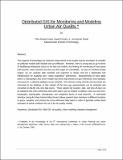Distributed GIS for Monitoring and Modeling Urban Air Quality
Author(s)
Yeang, Chen-Hsiang, 1969-; Ferreira, Joseph Jr; Ismail, Ayman
Downloadmit_distributed_GIS_cupum99.pdf (429.2Kb)
Metadata
Show full item recordAbstract
The progress of technology has made the measurement of air quality and the simulation of complex air pollution models both feasible and cost-effective. However, there is a long way to go in terms of facilitating widespread access to the data and models, and linking the monitoring of trace gases with specific urban activities and land use that might be controllable. As part of a NASA-funded project, we are working with scientists and engineers to design and test a distributed GIS infrastructure for studying such "urban respiration" phenomena. Measurements of trace gases within a metropolitan area (from mobile and fixed instruments) are geo-referenced, time-stamped, and stored in a relational database server (Oracle). GIS services (using ArcInfo and ArcView) are connected to the database so that subsets of the trace gas measurements can be extracted and converted on-the-fly into GIS data layers. These subsets (by location, date, and time-of-day) can be displayed and cross-referenced with other layers such as weather conditions, land use and cover, topography, hydrography, demography, and congestion levels of road networks. A web-based interface (using ArcView Internet Map Server) allows research team members at different locations to query, visualize, and process the cross-referenced data layers in order to generate surface level estimates of initial conditions for use in the air quality models.
Date issued
1999-09Publisher
Proceedings of the 6th International Conference in Urban Planning and Urban Management
Citation
URBANISTICA
Series/Report no.
114
Keywords
distributed GIS, Web GIS, air quality, urban modeling, database management
Collections
The following license files are associated with this item: